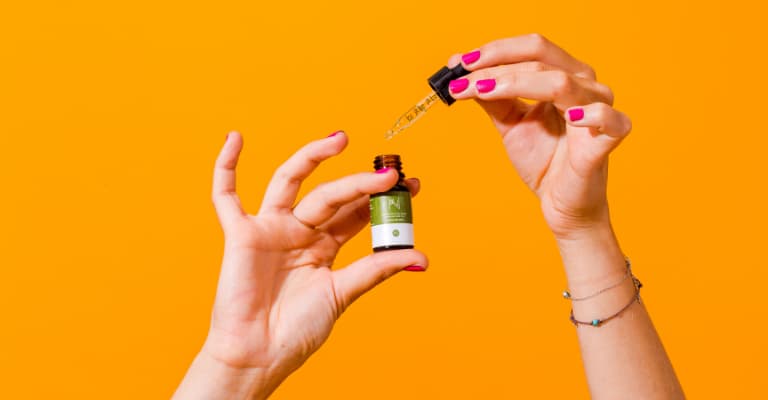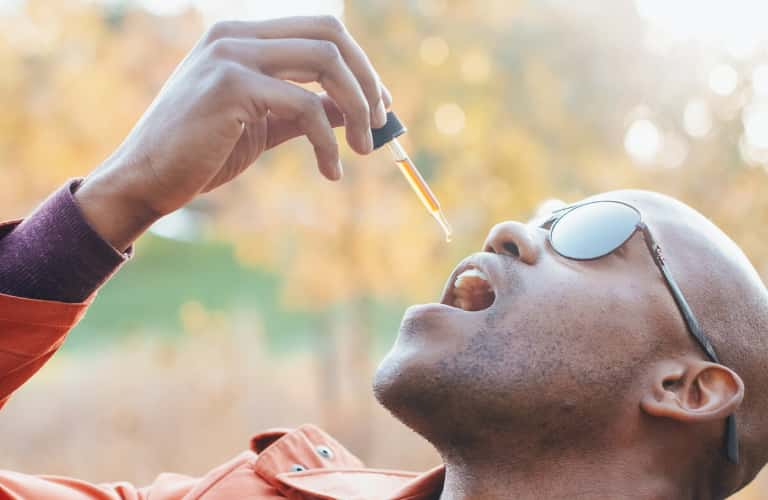April 10, 2020
The Entourage Effect and Cannabis Terpenes by Ahmed Mir

By: Ahmed Mir
Reviewed by: Dr. Abraham Benavides
A woman pinches CBD oil from a tincture
Source: The Entourage Effect And Cannabis Terpenes | Nature & Bloom
Nature & Bloom founder Ahmed Mir teaches us about the entourage effect and the role terpenes play in CBD oil.
When you’re new to cannabidiol (CBD), researching which product to start with can take some time. You’ll most likely come across articles talking about the synergies of cannabinoids when consumed as a whole plant extract v.s. a refined compound.
This is due to it being widely accepted that pure CBD is a much less desirable agent to boost your endocannabinoid system than CBD products with a more comprehensive cannabinoid profile.
Full and broad-spectrum products feature constituents naturally found in the plants which are otherwise lost in production when manufacturing pure CBD isolate.
This diverse profile is known to create the entourage effect, which refers to how compounds found in cannabis interact synergistically, producing a result greater than the sum of each part when used in isolation.
CBD products that allow you to experience the entourage effect are often referred to as being whole-plant based, including full-spectrum and broad-spectrum CBD oil.
Let’s dive into the backstory…
The Synergy of Cannabinoids and Terpenoids
A Venn Diagram of terpenes, flavonoids and essential oils, and cannabinoids
Source: The Entourage Effect And Cannabis Terpenes | Nature & Bloom
The entourage effect is a term coined by now famous Professors Raphael Mechoulam and Shimon Ben-Shabat in a 1998 research study published in the European Journal of Pharmacology.
This groundbreaking piece of research analysed the interactions between cannabinoids produced by our body called endocannabinoids, suggesting they work better in synergy together rather than in isolation.
A year later, the duo published a follow-up research article outlining the case with a similar effect for plant cannabinoids, also known as phytocannabinoids.
These studies concluded that cannabis compounds work better when together, improving the overall effect of cannabinoids.
More recent research from cannabis expert Dr. Ethan B. Russo also tends to agree that one molecule is unlikely to yield the same benefits as derived from the whole cannabis plant, which has a factory of phytochemicals at its disposal.
All this research suggests the hypothesis that the entourage effect exists, but it’s still a theory nonetheless.
Whole Plant Extracts
A man takes CBD oil from a tincture
Source: The Entourage Effect And Cannabis Terpenes | Nature & Bloom
Examples of full plant extracts include broad-spectrum and full-spectrum CBD oils which are primarily liquid forms of the hemp flower in its entirety.
The only difference between the two is that broad-spectrum removes the psychoactive THC, leaving a product with 0 percent detectable THC (full-spectrum contains traces of THC as in the hemp plant).
This type of CBD is often favored in countries where THC in any form is illegal, or by individuals who are drug tested (always consume at your own risk). Fortunately, broad-spectrum CBD does share the potential benefits of the entourage effect, just without any THC.
While researchers might relatively well accept the existence of the entourage effect, the reasons exactly behind its mechanics are still somewhat of a mystery.
Yes, it’s known that compounds in cannabis work together but what isn’t fully established is how exactly this occurs with the thousands of variations of cannabinoids, terpenes, and other plant constituents found in full or broad-spectrum CBD products.
The significant components that a whole plant CBD extract includes:
- Phytocannabinoids: A variety of over 60 known, reported plant-derived cannabinoids. These interact directly with cannabinoid receptors found throughout the human body.
- Terpenes: Non-intoxicating and organic compounds found abundantly in nature, including in cannabis flowers. Common terpenes include Limonene found in orange and lemon peel, and Linalool found in lavender.
- Flavonoids: A group of plant chemicals known as phytonutrients found in almost all plants and vegetables; responsible for the vivid colors we often see in plants.
- Fatty acids, including omega-3 and omega-6.
In respect to CBD products, only a few of these terpenes are found in large quantities across full-spectrum CBD oils. Still, there’s a broader tail end of both minor cannabinoids and terpenes found in minute quantities interacting with other aspects in the plant to further express the effect(s) of the CBD when used as a whole plant extract.
Anecdotal reports also suggest that most people are fans of full-plant over pure CBD extracts, mirroring how cannabinoids along with other plant compounds are found in nature.
These extracts contain trace amounts of other cannabinoids which researchers are examining for their own potential therapeutic uses, including CBG and CBC along with terpenes.
Further purified CBD known as CBD isolate does not contain any of these other beneficial compounds from the cannabis plant to experience an entourage effect.
CBD Can Regulate THC
A woman happily frames her face with a CBD oil tincture
Source: The Entourage Effect And Cannabis Terpenes | Nature & Bloom
Scientific studies examining the interactions and relationship between THC and CBD is probably the most established of all the other cannabinoids.
THC is known to directly bind to one (CB1) of two cannabinoid receptors (CB1 and CB2), which give traditional street weed its “high.”
However, CBD doesn’t bind to the receptors. Instead, it acts as a modulator of the downstream effects after THC and the CB1 receptor bind, thus regulating the effects of THC.
When isolated, THC is much more psychoactively potent than when used in combination with CBD, attributed to the way CBD mitigates the downstream effects via the cannabinoid receptors. This may also explain the way CBD reduces anxiety reported by users after taking too much THC, demonstrated in the rat study above.
This is an example of how cannabinoids used together can result in a different and often more favorable outcome.
The difference between isolated and combined compounds is abundantly clear when you look at pharmaceutical cannabinoids, which are used as medicines in the United States.
For example, Marinol is a synthetic version of THC often prescribed to increase appetite and reduce pain. This synthetic cannabinoid is absent of all other plant constituents. Still, it’s pure THC, making Marinol a highly psychoactive drug which has its uses in increasing appetite, but it can subject users to paranoia and doesn’t share the same effect users feel by consuming THC via full spectrum cannabis with a more balanced cannabinoid profile.
On the flipside, Sativex, a medicine used for MS spasticity and pain is a mix of both CBD and THC, which appears to have a much lower likelihood of adverse effects.
The CBD Entourage Effect and Minor Cannabinoids
While THC and CBD are the most common compounds associated with cannabis, there are over 100+ other minor cannabinoids also found in the plant which have their own effects.
Whole-plant CBD extracts contain a variety of these other cannabinoids and terpenoids in addition to CBD for an optimised effect.
The use of terpenes is nothing new – they’ve been used in aromatherapy for many years. Terpenoids are found often isolated across nature, but over 150 of them are found in cannabis and with profiles unseen elsewhere, allowing unique opportunities for synergistic collaboration.
It’s this ensemble of cannabinoids, terpenes, and other essential oils which make up the entourage effect and why the whole-plant CBD is the most popular type of CBD oil for sale.
Terpenes in CBD Oil
Terpenoids are the unsung heroes of cannabinoid wellness.
Nature and Bloom
While all the focus has been on CBD and its potential benefits, it’s becoming more apparent that terpenes play a significant part in the synergy found in broad and full-spectrum CBD oils.
Terpenes have their own effects that vary but compliment the use of cannabinoids for wellness. Most people report the experience of using a whole plant CBD product as being different from one of a CBD isolate-derived product.
All whole plant CBD products contain a mix of terpenes, but the exact makeup of the terpenoids in the oil can vary, and there is no guarantee the next bottle of CBD will contain the precise same terpene formulation as the last.
This is one of the main reasons behind why we created our new terpene specific range of CBD oils for day, night, and relief along with a CBD vape pen starter kit.
With three unique (all-natural) terpene blends along with broad-spectrum CBD extract and diluted in organic MCT oil (the vape pen contains no diluents).
Regardless of when you buy a bottle, this range of CBD oils will contain the same profile each time due to our reintroduced botanical terpenes for you to benefit from the entourage effect every time!
Nature and Bloom
In Conclusion
While most scientists believe in the entourage effect, it’s still only a hypothesis.
It’s likely that further research and study will confirm or deny the existence of an entourage effect and will be discussed in the future.
In the meantime, if you’re interested in trying a whole plant product, and are worried about the hempy taste – don’t be!
Nature & Bloom CBD oils use coconut-derived MCT oil as a carrier oil, this along with the added terpenes can mask the earthy taste of hemp without compromising on the benefits.
Head on over to Nature & Bloom to shop their high-quality CBD products and visit their blog to learn more about CBD!
Be sure to follow Nature & Bloom on Facebook and Instagram to keep up with their latest content.
Interested in having content featured in an upcoming blog post or issue of The Burgundy Zine? Head on over to the submissions page!
For all other inquiries, please fulfill a contact form.




